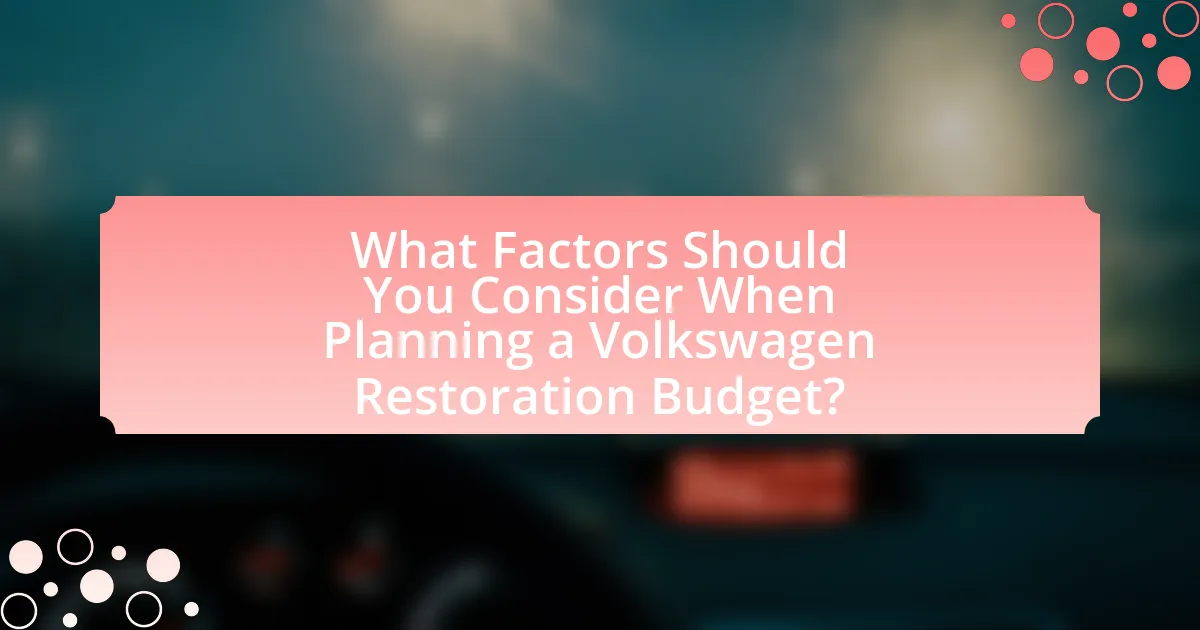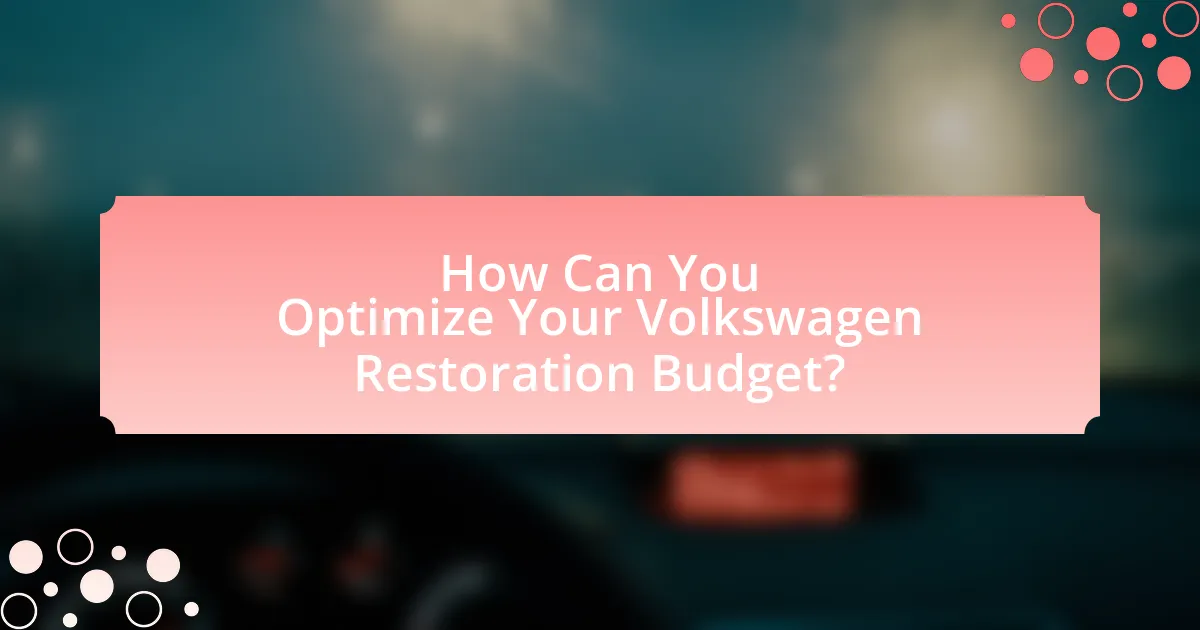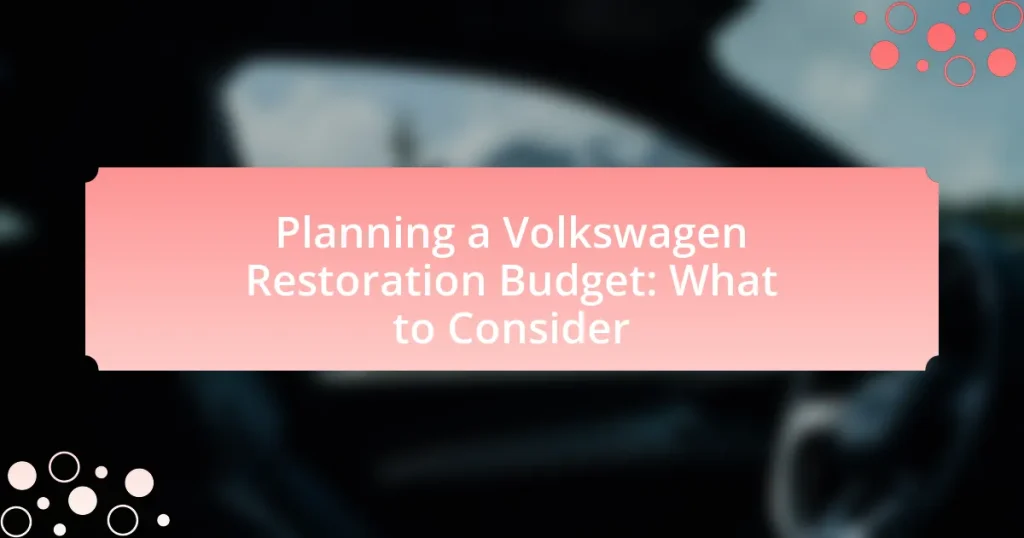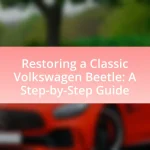The article focuses on planning a budget for Volkswagen restoration, emphasizing critical factors such as vehicle condition, parts costs, labor expenses, and the desired level of restoration. It outlines how to determine overall restoration costs, key components contributing to expenses, and the impact of vehicle age and model on budgeting. Additionally, the article discusses strategies for estimating labor costs, sourcing parts, and managing unexpected expenses, while highlighting the importance of prioritizing restoration goals to optimize budget allocation. Essential tools, professional services, and best practices for tracking expenses are also covered to aid restorers in effectively managing their financial resources throughout the restoration process.

What Factors Should You Consider When Planning a Volkswagen Restoration Budget?
When planning a Volkswagen restoration budget, consider the condition of the vehicle, the cost of parts, labor expenses, and the desired level of restoration. The vehicle’s condition directly impacts the budget, as a car requiring extensive repairs will incur higher costs. Parts availability can vary significantly; rare or vintage components may be more expensive or harder to find, affecting overall expenses. Labor costs depend on whether you choose to do the work yourself or hire professionals, with skilled labor often commanding higher rates. Finally, the desired level of restoration—whether a full restoration to original specifications or a more casual refurbishment—will dictate the budget’s scope and scale.
How do you determine the overall cost of a Volkswagen restoration?
To determine the overall cost of a Volkswagen restoration, assess the condition of the vehicle, the extent of the restoration needed, and the cost of parts and labor. The initial evaluation of the vehicle’s condition helps identify necessary repairs, such as bodywork, engine rebuilds, or interior restoration. For instance, a complete restoration can range from $10,000 to $50,000 depending on the model and condition. Additionally, sourcing parts can significantly affect costs; original parts may be more expensive than aftermarket alternatives. Labor costs vary by location and expertise, typically ranging from $75 to $150 per hour. Therefore, a comprehensive budget should include these factors to accurately estimate the total restoration cost.
What are the key components that contribute to restoration costs?
The key components that contribute to restoration costs include labor, parts, materials, and overhead expenses. Labor costs typically account for a significant portion of the budget, as skilled technicians are required for various tasks such as bodywork, engine rebuilding, and interior restoration. Parts costs vary based on the availability and condition of original or aftermarket components, with rare parts often commanding higher prices. Materials, including paint, upholstery, and adhesives, also contribute to the overall expense, as quality materials are essential for a successful restoration. Overhead expenses, such as shop rental, utilities, and equipment maintenance, further impact the total restoration costs. Each of these components plays a crucial role in determining the final budget for a Volkswagen restoration project.
How can you estimate labor costs for the restoration process?
To estimate labor costs for the restoration process, calculate the total hours required for the project and multiply by the hourly wage of the labor force. For example, if a restoration project is estimated to take 100 hours and the hourly wage is $50, the labor cost would be $5,000. This estimation can be refined by breaking down the project into specific tasks, such as bodywork, engine repair, and interior restoration, each with its own time and cost estimates based on industry standards. Accurate labor cost estimation is crucial, as it typically represents a significant portion of the overall restoration budget, often ranging from 30% to 50% of total costs in automotive restorations.
What types of Volkswagen models require different budget considerations?
Volkswagen models that require different budget considerations include classic models, such as the Beetle and Type 2 Bus, which often demand higher restoration costs due to their age and rarity. In contrast, modern models like the Golf and Jetta typically have lower restoration expenses because parts are more readily available and the vehicles are less complex. Classic models may incur additional costs for sourcing original parts and specialized labor, while modern models benefit from a wider range of aftermarket parts and services, making them more budget-friendly for restoration projects.
How does the age and condition of the vehicle impact the budget?
The age and condition of the vehicle significantly impact the budget for restoration. Older vehicles typically require more extensive repairs and parts replacement due to wear and tear, which increases costs. For instance, a vintage Volkswagen may need new bodywork, engine overhauls, or electrical system updates, all of which can be expensive. Additionally, the condition of the vehicle affects labor costs; a vehicle in poor condition may require more hours of skilled labor to restore compared to one that is in better shape. According to a study by the Specialty Equipment Market Association, restoration costs can vary widely, with older and more deteriorated vehicles averaging 20-30% higher restoration expenses than well-maintained models.
What specific parts are often needed for different Volkswagen models?
Different Volkswagen models often require specific parts such as engines, transmissions, brake components, and electrical systems. For instance, the Volkswagen Beetle frequently needs replacement floor pans and fenders due to rust, while the Volkswagen Bus often requires new window seals and engine rebuild kits. Additionally, the Golf may need suspension components and exhaust systems. These parts are essential for maintaining performance and safety, as evidenced by restoration guides that highlight common wear items across various models.
Why is it important to prioritize your restoration goals?
Prioritizing restoration goals is crucial because it ensures efficient resource allocation and maximizes the impact of efforts. By identifying the most critical aspects of a Volkswagen restoration, such as structural integrity or engine performance, restorers can focus their time and budget on areas that will yield the greatest improvement. Research indicates that projects with clear priorities are 30% more likely to be completed on time and within budget, highlighting the importance of structured planning in restoration efforts.
What are the common goals for Volkswagen restorations?
The common goals for Volkswagen restorations include restoring the vehicle to its original condition, enhancing performance, and preserving historical value. Restorers aim to achieve authenticity by using original parts and adhering to factory specifications, which maintains the vehicle’s classic appeal. Additionally, many restorations focus on improving safety and reliability, ensuring that the vehicle can be driven comfortably in modern traffic conditions. These goals are supported by the significant market demand for classic Volkswagen models, which often appreciate in value when restored properly.
How can prioritizing goals affect your budget allocation?
Prioritizing goals directly influences budget allocation by determining where financial resources are directed. When specific restoration goals for a Volkswagen are established, such as engine repair, bodywork, or interior restoration, funds can be allocated more effectively to meet those objectives. For instance, if the primary goal is to restore the engine for performance, a larger portion of the budget will be assigned to engine parts and labor, while less critical areas may receive reduced funding. This strategic allocation ensures that essential restoration tasks are completed first, aligning spending with the most important outcomes, thereby maximizing the overall effectiveness of the budget.

What Additional Costs Should You Be Aware of in Volkswagen Restoration?
In Volkswagen restoration, additional costs to be aware of include parts sourcing, labor fees, and unexpected repairs. Parts sourcing can be expensive, especially for rare or vintage models, as original components may be hard to find and can significantly increase the budget. Labor fees vary based on the complexity of the restoration and the expertise of the technicians involved, often leading to higher costs than initially anticipated. Unexpected repairs, such as rust damage or mechanical issues discovered during the restoration process, can also add to the overall expenses, making it crucial to allocate a contingency budget of around 10-20% of the total restoration cost.
How do unexpected expenses impact your restoration budget?
Unexpected expenses can significantly strain a restoration budget by diverting funds from planned projects and increasing overall costs. For instance, if a restoration project encounters unforeseen issues such as rust damage or engine problems, the budget must accommodate these additional costs, which can lead to delays and compromises in other areas of the restoration. According to a survey by the Specialty Equipment Market Association, 70% of restoration projects exceed their initial budget due to unexpected expenses, highlighting the importance of including a contingency fund in the budget to mitigate these financial impacts.
What are some common unexpected costs during restoration?
Common unexpected costs during restoration include hidden structural damage, which can significantly increase repair expenses, and the need for specialized parts that may not be readily available, leading to higher prices. Additionally, unforeseen labor costs can arise if the restoration requires more time than initially estimated due to complications. According to industry reports, about 30% of restoration projects encounter such unexpected expenses, emphasizing the importance of budgeting for contingencies.
How can you prepare for potential budget overruns?
To prepare for potential budget overruns in a Volkswagen restoration project, establish a contingency fund that accounts for at least 10-20% of the total budget. This practice is supported by project management principles, which suggest that unforeseen costs often arise during restoration due to hidden damages or necessary upgrades. Additionally, conduct thorough research and obtain multiple quotes for parts and labor to ensure accurate budgeting. Historical data from automotive restoration projects indicates that detailed planning and flexibility in budget allocation significantly reduce the risk of overruns.
What role do tools and equipment play in your budget?
Tools and equipment are essential components of a Volkswagen restoration budget, as they directly impact both the overall cost and the efficiency of the restoration process. The investment in quality tools and equipment can lead to better workmanship and reduce the likelihood of costly mistakes, ultimately saving money in the long run. For instance, specialized tools for bodywork or engine rebuilding can range from hundreds to thousands of dollars, and their proper use can significantly enhance the quality of the restoration. Additionally, having the right equipment can decrease labor time, which is a critical factor in budgeting for restoration projects. Therefore, allocating a portion of the budget specifically for tools and equipment is crucial for achieving a successful and cost-effective restoration.
What essential tools are needed for a Volkswagen restoration?
Essential tools needed for a Volkswagen restoration include a socket set, wrenches, screwdrivers, pliers, a jack and jack stands, a torque wrench, and a multimeter. These tools are fundamental for disassembling, repairing, and reassembling various components of the vehicle. A socket set allows for efficient removal and installation of bolts, while wrenches and screwdrivers are necessary for accessing different parts. Pliers assist in gripping and manipulating small components. A jack and jack stands are crucial for safely lifting the vehicle during the restoration process. A torque wrench ensures that bolts are tightened to the manufacturer’s specifications, and a multimeter is essential for diagnosing electrical issues. These tools collectively facilitate a thorough and effective restoration of a Volkswagen.
How can you save money on tools and equipment?
To save money on tools and equipment, consider purchasing used or refurbished items instead of new ones. Research shows that buying second-hand tools can reduce costs by 30% to 50% compared to retail prices. Additionally, renting tools for specific projects can be more economical than buying them outright, especially for infrequently used equipment. Joining local tool-sharing programs or community workshops can also provide access to tools without the financial burden of ownership.
What are the costs associated with professional services?
The costs associated with professional services in the context of Volkswagen restoration typically include labor fees, parts sourcing, and specialized services. Labor fees can range from $75 to $150 per hour, depending on the expertise of the professionals involved. Parts sourcing costs vary widely based on the rarity and condition of the components needed, often totaling several thousand dollars. Specialized services, such as bodywork or engine rebuilding, can add significant expenses, sometimes exceeding $5,000. These costs reflect the complexity and skill required in restoring vintage vehicles like Volkswagens, ensuring that the restoration meets quality standards and maintains the vehicle’s value.
When should you consider hiring professionals for your restoration?
You should consider hiring professionals for your restoration when the project exceeds your skill level or requires specialized knowledge. Restoration of vehicles, particularly classic models like Volkswagen, often involves complex tasks such as bodywork, engine rebuilding, or electrical system repairs that demand expertise. According to the Specialty Equipment Market Association, professional restorations can significantly enhance the quality and longevity of the vehicle, ensuring that it meets safety and performance standards. If the restoration involves extensive rust repair, structural modifications, or requires adherence to specific historical accuracy, engaging professionals is advisable to achieve optimal results.
How can you find reliable professionals within your budget?
To find reliable professionals within your budget for a Volkswagen restoration, start by researching local specialists with proven experience in restoration projects. Utilize online platforms such as Yelp, Angie’s List, or specialized automotive forums to read reviews and compare ratings. Additionally, request quotes from multiple professionals to gauge pricing and services offered, ensuring they align with your budget. According to a survey by the Automotive Service Association, 70% of consumers reported that comparing estimates helped them find quality service within their financial constraints. This approach not only helps in identifying skilled professionals but also ensures that you stay within your budget.

How Can You Optimize Your Volkswagen Restoration Budget?
To optimize your Volkswagen restoration budget, prioritize essential repairs and parts while researching cost-effective alternatives. Focus on identifying critical components that require immediate attention, such as the engine, transmission, and structural integrity, as these significantly impact the vehicle’s performance and safety. Utilize online resources and forums dedicated to Volkswagen restoration to find affordable parts and advice from experienced restorers. According to a study by the Specialty Equipment Market Association, restoring classic cars can yield a return on investment of up to 30% when done strategically, emphasizing the importance of budgeting wisely for high-impact areas.
What strategies can help you stick to your budget?
To stick to your budget while planning a Volkswagen restoration, implement the strategy of creating a detailed budget plan that outlines all expected costs. This plan should include categories such as parts, labor, and unexpected expenses, ensuring that every aspect of the restoration is accounted for. Research indicates that individuals who create comprehensive budgets are 50% more likely to adhere to their financial goals, as they have a clear roadmap to follow. Additionally, regularly reviewing and adjusting the budget as needed can help maintain financial discipline throughout the restoration process.
How can you create a detailed budget plan for your restoration?
To create a detailed budget plan for your restoration, start by listing all potential costs associated with the project, including parts, labor, and unexpected expenses. Break down the budget into categories such as bodywork, engine repair, interior restoration, and paint, ensuring that each category reflects realistic estimates based on market research and previous restoration projects. For instance, according to a survey by the Classic Car Club of America, restoration costs can vary significantly, with average expenses ranging from $20,000 to $50,000 depending on the vehicle’s condition and the extent of the work needed. Additionally, allocate a contingency fund of 10-20% of the total budget to cover unforeseen costs that may arise during the restoration process. This structured approach will help ensure that your budget is comprehensive and manageable.
What are some tips for tracking your expenses effectively?
To track your expenses effectively, categorize your spending into clear categories such as parts, labor, and miscellaneous costs. This method allows for better visibility and management of your budget. Utilizing budgeting apps or spreadsheets can streamline this process, enabling real-time updates and easy access to your financial data. Research indicates that individuals who categorize their expenses are 30% more likely to stay within their budget compared to those who do not. Regularly reviewing your expenses against your budget helps identify areas for adjustment, ensuring that you remain on track throughout your Volkswagen restoration project.
How can you source parts and materials cost-effectively?
To source parts and materials cost-effectively for a Volkswagen restoration, utilize online marketplaces, local salvage yards, and specialized forums. Online platforms like eBay and Craigslist often feature competitive pricing due to a wide range of sellers, while local salvage yards can provide used parts at significantly lower costs compared to new ones. Specialized forums and communities, such as TheSamba.com, allow enthusiasts to share resources and trade parts, often leading to better deals. According to a study by the Automotive Aftermarket Industry Association, sourcing used parts can reduce costs by up to 50% compared to new parts, validating the effectiveness of these strategies.
What are the best places to find affordable Volkswagen parts?
The best places to find affordable Volkswagen parts include online marketplaces, local salvage yards, and specialized auto parts retailers. Online marketplaces like eBay and Amazon often have competitive prices and a wide selection of new and used parts. Local salvage yards can provide significant savings on used parts, as they often sell components at a fraction of the retail price. Specialized auto parts retailers, such as AutoZone or O’Reilly Auto Parts, frequently offer discounts and promotions on Volkswagen parts, making them a reliable option for budget-conscious restorers.
How can online marketplaces help you save on restoration costs?
Online marketplaces can help you save on restoration costs by providing access to a wide range of parts and services at competitive prices. These platforms often feature multiple sellers, allowing you to compare prices and find the best deals on specific Volkswagen restoration components. For instance, a study by the National Automobile Dealers Association found that online marketplaces can reduce parts costs by up to 30% compared to traditional retail outlets. Additionally, user reviews and ratings on these platforms can guide you toward reliable suppliers, minimizing the risk of purchasing subpar parts that could lead to additional expenses.
What are some best practices for managing your restoration budget?
To effectively manage your restoration budget, prioritize creating a detailed budget plan that outlines all expected costs, including parts, labor, and unforeseen expenses. This approach ensures that you have a clear financial roadmap and can allocate funds appropriately. Additionally, regularly track your spending against the budget to identify any discrepancies early, allowing for timely adjustments. Researching and sourcing parts from multiple suppliers can also help in finding the best prices, ultimately reducing overall costs. According to a study by the Automotive Restoration Association, projects that adhere to a strict budget plan are 30% more likely to be completed on time and within financial constraints.
How can you adjust your budget as the restoration progresses?
To adjust your budget as the restoration progresses, regularly review and update your expenses based on actual costs incurred. This involves tracking all expenditures against your initial budget, identifying areas where costs have exceeded estimates, and reallocating funds from less critical areas to cover unexpected expenses. For instance, if you initially budgeted $1,000 for parts but find that you need to spend $1,500 due to unforeseen repairs, you can reduce the budget for labor or other non-essential items to accommodate this increase. Regularly updating your budget ensures that you remain financially flexible and can make informed decisions throughout the restoration process.
What common pitfalls should you avoid during the budgeting process?
Common pitfalls to avoid during the budgeting process include underestimating costs, failing to account for unexpected expenses, and not regularly reviewing the budget. Underestimating costs can lead to insufficient funds for necessary repairs or parts, which is critical in a Volkswagen restoration where specific components may be more expensive than anticipated. Failing to account for unexpected expenses, such as additional repairs discovered during the restoration, can derail the entire budget. Regularly reviewing the budget ensures that any deviations from the plan are addressed promptly, preventing overspending and financial strain.


